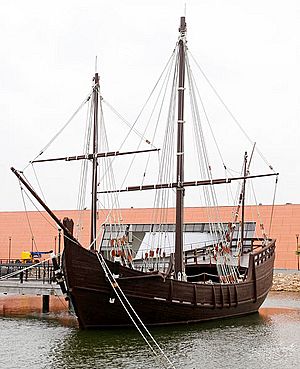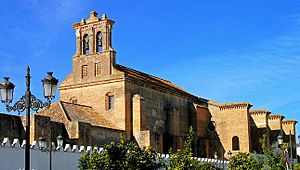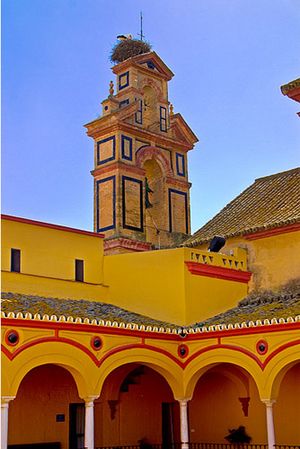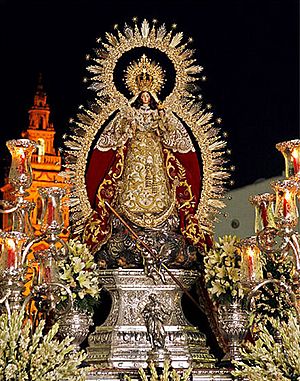Moguer facts for kids
Quick facts for kids
Moguer
|
|||
|---|---|---|---|
|
Municipality and city
|
|||
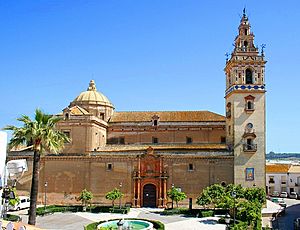
Iglesia de Nuestra Señora de Granada
|
|||
|
|||
| Country | |||
| Autonomous community | |||
| Province | Huelva | ||
| Comarca | Metropolitan District of Huelva | ||
| Area | |||
| • Total | 204 km2 (79 sq mi) | ||
| Elevation | 51 m (167 ft) | ||
| Demonym(s) | Moguereños | ||
| Time zone | UTC+1 (CET) | ||
| • Summer (DST) | UTC+2 (CEST) | ||
| Postal code |
21800 - 21130 (Mazagón)
|
||
| Official language(s) | Spanish | ||
Moguer is a city and municipality in the province of Huelva, Andalusia, Spain. In 2022, about 22,623 people lived there. The city covers an area of 204 square kilometers.
Moguer has been home to people for a very long time. The modern city started in 1333. This was when the "Seigneury of Moguer" was created. Important buildings like the Santa Clara Monastery were built soon after. Moguer grew quickly, becoming a key town. Its economy relied on farming, fishing, and trade through its river port.
Moguer played a big part in Christopher Columbus's first voyage. Columbus got help from important people in Moguer. The The Niño brothers from Moguer even provided the ship Niña. When Columbus returned, he fulfilled a promise by spending a night at the Santa Clara Monastery church. Today, Moguer and nearby Palos de la Frontera are part of the lugares colombinos. This is a tourist route of places linked to Columbus's journey.
Moguer's port stayed important for trade. It exported local wines and goods to other countries. In the 20th century, growing strawberries became very important. This led to new economic growth. Moguer is now Spain's top strawberry-growing area.
The municipality of Moguer includes the towns of Moguer and Mazagón. It also has farms and natural forest areas. Moguer is famous as the birthplace of Juan Ramón Jiménez. He was a poet who won the Nobel Prize for Literature. He wrote the famous book Platero y yo.
Contents
Geography
Where is Moguer located?
Moguer is in the southwest of Spain. It is in the "Flatland" area of Huelva province. To the north is the Río Tinto river. The Atlantic Ocean is to the south.
The city of Moguer is 51 meters above sea level. It is 19 kilometers from Huelva, the provincial capital. It is also 80 kilometers from Seville, the capital of Andalusia. Moguer is close to Palos de la Frontera. Its total area is 204 square kilometers.
How to get to Moguer
You can reach Moguer mainly by the Autovía A-49/E-1 highway. Other roads like the N-422 and A-494 also connect to Moguer.
What is the land like in Moguer?
Moguer's land is made of sandy clay. It has three main areas: countryside, wetlands (marshes), and coast. The Río Tinto river and its marsh are in the north. In the south, there are 13 kilometers of natural beaches. There are also sand hills called Arenas Gordas. The rest of the area is countryside with streams. Some places have curved rock formations called cabezos.
What is the climate like in Moguer?
Moguer has a Mediterranean climate. It is influenced by the Atlantic Ocean. Moguer is one of the warmest and sunniest cities in Europe. The average temperature is 19.2°C. It gets 2,984 hours of sunshine each year.
July is the hottest month, with temperatures sometimes over 40°C. January is the coolest, with lows around 7°C and highs around 17°C.
| Jan | Feb | Mar | Apr | May | Jun | Jul | Aug | Sep | Oct | Nov | Dec | Average | |
|---|---|---|---|---|---|---|---|---|---|---|---|---|---|
| Average high temperature (°C) | 17 | 17.9 | 20.9 | 22 | 26.2 | 30 | 34 | 33 | 29.5 | 25 | 20.9 | 18 | 24,3 |
| Average low temperature (°C) | 6.9 | 7.9 | 8.5 | 11 | 15.2 | 17.9 | 20.5 | 22.2 | 20 | 15.9 | 13.8 | 10.2 | 14.1 |
| Precipitation (mm) | 62 | 43 | 72 | 40 | 28 | 8 | 2 | 4 | 20 | 52 | 62 | 63 | 38 |
Demography
How many people live in Moguer?
Before 1333, people lived in different places in the area. After 1333, they started living in the main town. The population grew to about 5,000 and stayed around that number for a long time.
Between 1900 and 1970, Moguer's population was about 7,000–8,000. Since 1970, it has grown a lot. In 2021, there were 22,061 people, the most in Moguer's history. About 50.13% are male and 49.87% are female.
| Moguer: Population graphic 1900–2021 | ||||||||||||||||||||||||||||||||||||||||||||||||||||||||||||||||||||||||||||||||||||
|---|---|---|---|---|---|---|---|---|---|---|---|---|---|---|---|---|---|---|---|---|---|---|---|---|---|---|---|---|---|---|---|---|---|---|---|---|---|---|---|---|---|---|---|---|---|---|---|---|---|---|---|---|---|---|---|---|---|---|---|---|---|---|---|---|---|---|---|---|---|---|---|---|---|---|---|---|---|---|---|---|---|---|---|---|
|
|
|
|
|||||||||||||||||||||||||||||||||||||||||||||||||||||||||||||||||||||||||||||||||
| Source: INE; Smallest unit: 500 inhabitants | ||||||||||||||||||||||||||||||||||||||||||||||||||||||||||||||||||||||||||||||||||||
History
Early Settlements
People have lived in Moguer for a very long time. Neolithic, Phoenician, and Roman remains have been found. The Romans built a town called Urium here.
Middle Ages
When Muslims arrived, Moguer was called Mogauar or Mogur. The Almohad Castle of Moguer and other structures are from this time. The Order of Santiago conquered Moguer around 1239–1240.
The Seigneury of Moguer
In 1333, Moguer became the first seigneury (a type of feudal land) in the area. Alfonso XI of Castile gave it to Alonso Jofré Tenorio. Moguer became a rich town under his rule. The Casa de Portocarrero family later took over. They built more buildings, like the San Francisco Convent.
Moguer was known as a loyal town to the Spanish Crown. In 1642, Philip IV of Spain made Moguer a city. In 1779, Charles III called it "Very Noble and Very Loyal." So, Moguer is known as the "Very Noble and twice Very Loyal City."
Moguer and Columbus's First Voyage
In the 15th century, Moguer's economy was based on farming, fishing, and trade. Its river port was very busy.
Moguer played a big role in Christopher Columbus's first voyage. Many sailors from Moguer joined the trip. The caravel Niña was built in Moguer. It was owned by the Niño brothers from Moguer. Columbus got important help from the Niño brothers and others in Moguer.
When Columbus returned from America, he went to the Santa Clara Monastery church. He did this to fulfill a promise he made during a storm.
Later History
In the 16th century, Moguer traded a lot with the Americas. Many people from Moguer explored new lands. For example, Pedro Alonso Niño discovered parts of Venezuela. Bartolome Ruiz helped discover the Pacific Ocean.
The 17th century was hard for Spain, and Moguer also faced difficulties. The population went down. But in 1642, Moguer was officially named a "city."
The 18th century brought more stability. The wine industry grew, selling wine to America and Europe. The 1755 Lisbon earthquake damaged many buildings in Moguer. Many had to be rebuilt, like the Parish Church of Our Lady of Granada.
Modern History
In the 19th century, Moguer was a large town. It became the head of a new legal district. The wine industry continued to be very important. However, the river port became less busy due to silting.
On December 23, 1881, the poet Juan Ramón Jiménez was born in Moguer. He wrote Platero y yo and won the Nobel Prize. In the early 20th century, a disease called phylloxera hurt the vineyards. This caused the population to decline. But in the 1970s, growing strawberries brought new life to Moguer. Today, strawberries and raspberries drive Moguer's economy. Construction and tourism are also important.
Economy
What are Moguer's main industries?
For a long time, Moguer's economy was based on fishing and sea trade. In the Middle Ages, farming also grew. People grew wheat, grapes for wine, and other crops. They also fished.
Later, industries like making soap, bread, and bricks developed. Moguer also benefited from trade with the Americas.
The 17th century was a tough time for Spain's economy. But in the 18th century, trade grew again, especially wine.
In the 19th century, wine production boomed. But in the early 20th century, a disease hurt the grapevines. The chemical industry helped a bit. However, the biggest change came with strawberry farming in recent decades. Moguer is now Spain's top strawberry producer. More recently, raspberries and blueberries are also grown.
| Hectares | |
|---|---|
| Spain | 8,296 |
| Andalusia | 7,060 |
| Huelva (province) | 6,800 |
| Moguer | 2,278 |
In 2008, 2,278 hectares in Moguer were used for strawberries. This was 27.5% of Spain's total.
The construction and service industries have also grown. Tourism in Mazagón has led to more hotels. Moguer also has an aerospace center, the I.N.T.A. This center researches renewable energy and tests rockets and drones. It is becoming a top European center for unmanned systems.
Agriculture
Farming has always been key to Moguer's economy. Today, the main crops are strawberries and raspberries. These are grown using modern methods like hydroponics in plastic tunnels.
The first local experiments with strawberries started in the late 1970s. Over time, farming techniques improved. This made strawberries the base of the local economy.
Administration and Municipal Infrastructure
Municipal Buildings
The main town hall is called the Casa Consistorial. It is in the historic center. Other local government offices are in newer buildings. The municipal archive is in part of the San Francisco Convent.
Municipal Politics
The current mayor of Moguer is Gustavo Cuéllar Cruz. He has been mayor since 2011. The Municipal Corporation has 21 councillors. In the 2019 elections, the PSOE-A party won 12 seats. The People's Party won 7 seats. The Mazagón Neighborhood Association won 2 seats.
| 1979–1983 | Julián Gamón Domínguez | UCD |
| 1983–1987 | Francisco Díaz Olivares | PSOE-A |
| 1987–1991 | Francisco Díaz Olivares | PSOE-A |
| 1991–1995 | Francisco Díaz Olivares Rosario Ballester Angulo (from 1994) |
PSOE-A |
| 1995–1999 | Manuel Burgos Cruzado | PP |
| 1999–2003 | Rosario Ballester Angulo | PSOE-A |
| 2003–2007 | Juan José Volante Padilla | PP |
| 2007–2011 | Juan José Volante Padilla | PP |
| 2011–2015 | Gustavo Cuéllar | PSOE-A |
| 2015–2019 | Gustavo Cuéllar | PSOE-A |
| 2019– | Gustavo Cuéllar | PSOE-A |
The city council holds public meetings every month.
Security and Justice
Moguer has three types of security forces:
- The local police, with about 30 officers.
- The Civil Guard, a national police force.
- Civil defense volunteers, who help in emergencies.
Moguer is also a legal district. It has courts for Moguer and nearby towns.
Health and Education
Moguer has two health centers. They are part of the Andalusian Health Service.
The town has many schools:
- Nursery schools for young children.
- Primary schools like Pedro Alonso Niño School.
- Secondary schools like Juan Ramón Jiménez Institute.
- Continuing education centers for adults.
Sports
Moguer has two large sports centers. They have football fields, running tracks, and courts for various sports. There are also indoor pavilions and outdoor pools.
The Club Balonmano Pedro Alonso Niño is a notable handball team from Moguer. It plays in a national league.
Natural Areas
More than 60% of Moguer's land is natural. Some of these areas are protected.
- Doñana Natural Park: This park has dunes, forests, and wetlands. About 3,200 hectares of the park are in Moguer. It is one of Europe's largest ecological reserves. UNESCO made it a World Heritage Site in 1994.
- Paraje Natural Laguna de las Madres y Palos: This area has many different animals and plants.
- Dehesa del Estero Domingo Rubio: A pine forest with various plants and animals like wild boars and otters.
- Marismas y Riberas del Tinto: Marshes and riverbanks of the Río Tinto.
- Playas de Mazagón: Beaches and sand hills. Part of this area is protected.
Main Sights
- Santa Clara Monastery: Founded in 1337. It is a national monument. This is one of the most important lugares colombinos in Moguer. Columbus fulfilled a promise here.
- Casa Consistorial: The Town Hall, built in the late 18th century.
- Birthplace House of Juan Ramón Jiménez: The house where the Nobel Prize winner was born.
- Zenobia and Juan Ramón Jiménez House Museum: An 18th-century house with the poet's belongings.
- Moguer Castle: An old Almohad building. It has a Roman villa origin.
- Moguer Parish Cemetery: Includes the pantheon for Zenobia and Juan Ramón Jiménez.
- Parish Church of Our Lady of Granada: Built in the 18th century on older ruins. It is very large.
- Pinete Fountain: A 13th-century fountain.
- Chapel of the Hospital of Corpus Christi: A Gothic–Mudéjar building from the 14th century.
- Puerto de la Ribera: The old river port where the caravel La Niña was built.
- Convent of St. Francis: Begun in the late 15th century. It now holds the Municipal Historical Archives.
- Montemayor Hermitage: A mix of old and new architecture.
Notable People
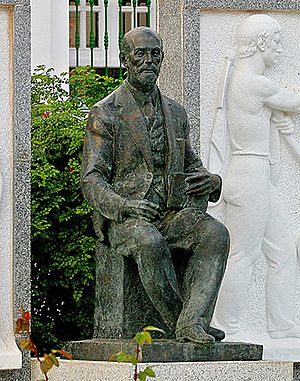
Many people from Moguer have been famous sailors, church figures, politicians, and artists.
- The Niño brothers: Famous sailors from Moguer who helped Christopher Columbus on his voyages.
- Juan Ramón Jiménez: Born in Moguer in 1881. He was a poet who won the Nobel Prize for Literature.
- Alonso Jofre Tenorio: The first lord of Moguer.
- Portocarrero family: An important noble family who ruled Moguer for many years.
- Pedro Alonso Niño: A discoverer of the coasts of Venezuela.
- Bartolomé Ruiz: A pilot who helped Francisco Pizarro discover Peru.
- Fray Antonio de Olivares: A priest who founded the city of San Antonio, Texas.
- Diego García de Moguer: A pilot who explored the South American coast.
- Juan Ladrillero: An explorer who discovered parts of the Straits of Magellan.
- La Parrala: A famous flamenco singer.
- Francisco Garfias López: A poet who won the National Prize for Poetry.
Craftsmanship and Gastronomy
Moguer has a rich tradition of crafts. These include coopering (making barrels), bobbin lace, and embroidery.
Moguer's food features seafood like cuttlefish with beans and skate in paprika. They also have white wines and orange wine. These wines are part of the Denominación de Origen Condado de Huelva.
Other special products are a pastry called "La Victoria" and vermouth. Of course, strawberries are also a key product.
Culture and Traditions
Moguer has many festivals and celebrations throughout the year.
The Days of Our Lady honor Our Lady of Montemayor, Moguer's patron saint. This happens around September 8. There is a special church service and a procession through the streets. A fun fair also takes place with many booths.
The Pilgrimage of Our Lady of Montemayor is held every second weekend of May. Thousands of pilgrims visit the shrine in the pine forests.
Easter in Moguer is very important. Different brotherhoods hold processions from Palm Sunday to Holy Saturday.
The Romería del Rocío is a pilgrimage to the village of El Rocío on Pentecost weekend. People from Moguer have been part of this pilgrimage for centuries. Juan Ramón Jiménez wrote about it in Platero y yo:
Platero – I said to him – we're going to wait for the Carts. The sound came from the faraway forest of Doñana, the mystery of the pine barren of Las Animas, the freshness of Las Madres and the two Fresnos, the smell of la Rocina...
They passed, first on burros, mules and horses dressed in the Moorish style and manes braided, the happy pairs...
Platero, then, folded his hands and like a woman he kneeled – a skill of his! -, gentle, humble, and consenting.
Behind the carts, like beds, hung in white...
And the majordomo -¡Viva! Long live the Virgin of Rocíoooooo!
¡Vivaaaaa!, – bald, dry, red, his wide-brim hat pushed back and the golden rod resting in the stirrup....—From "El Rocío"; chapter XLVII of Platero y yo, by Juan Ramón Jiménez.
Corpus Christi is another celebration. The procession route is decorated with plants and altars.
Other cultural events celebrate the discovery of the Americas and Juan Ramón Jiménez. The Fundación Juan Ramón Jiménez gives out awards like the "Silver Parsley."
There is also an annual Festival of Flamenco Singing in July.
Twin towns and sister cities
Moguer is connected with these cities:
 Jerez de los Caballeros, Spain
Jerez de los Caballeros, Spain Malgrat de Mar, Spain
Malgrat de Mar, Spain Telde, Spain
Telde, Spain San Antonio, USA
San Antonio, USA
See also
 In Spanish: Moguer para niños
In Spanish: Moguer para niños





